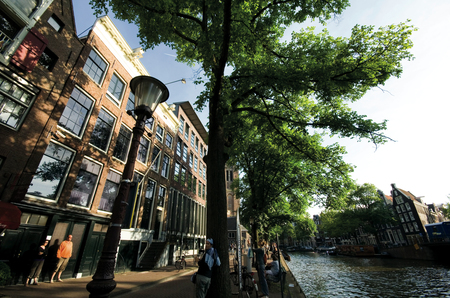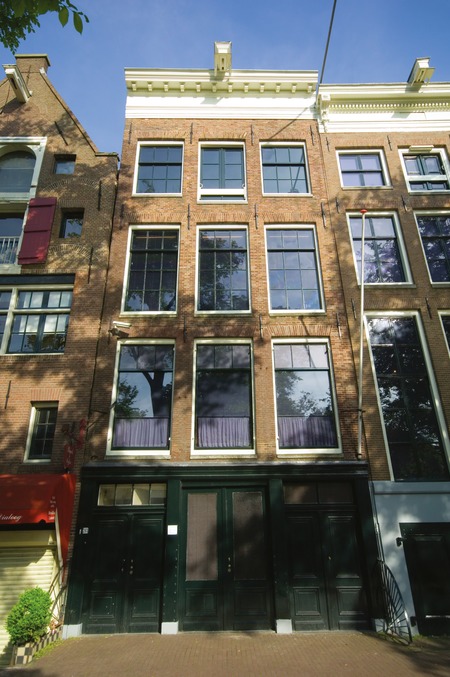I had read The Diary of Anne Frank while in high school and knew of her story. Her personal journal describes the most trying times—becoming a woman while in hiding from the Nazis. Something about her story compelled me to learn more and visit the very place where she, her family and 4 other family friends spent two years living in a secret annex in Amsterdam.
Family History
Anne Frank was born on June 12, 1929, the second daughter of Otto and Edith Frank. Her older sister Margot was also born in Frankfurt am Main, Germany just three years earlier. As Hitler and the Nazi party began to gain power, anti-Semitism became common place. So Otto decided to move to the Netherlands in 1933. This country had been neutral during World War I and therefore considered a safe place for Jewish settlement.
Anne was only four at the time of the move and quickly grew to love her new home. Then on May 10, 1940 Hitler invaded The Netherlands, who surrendered five days later. It wasn’t until 1942, when Margot received a letter to report to a work camp in Germany, that the family went into hiding.
The Secret Annex, where Anne Frank lived
Otto owned a company that made jam and under Nazi occupation, Jews weren’t allowed to own businesses. So he gave his company to two of his managers. Preparing for the inevitable, Otto arranged to move his family into the jam factory, where hidden living quarters provided secluded shelter. A bookcase was built to hide the entrance to the annex. Other Jews joined the Frank family in the secret annex—Hermann and Auguste van Pels, their son Peter and Otto’s friend Fritz Pfeffer.
Only four employees knew of this arrangement. These employees would be the life blood of those sequestered here, bringing necessary supplies of food, clothing, staples and occasional newspapers at great risk to themselves. Even though food was scarce, they never failed to bring what little they had. The four trusted employees would collect grocery lists and other needs and sometimes one or two joined the group for lunch up in the upper annex floors.
A tour of the hidden living quarters provided an appreciation of the difficult and scary times these people shared. At all times, the draperies remained closed creating a claustrophobic environment. The residents of the annex followed a strict daily schedule only moving at times they wouldn’t heard by factory workers so as to remain undiscovered.
Anne Frank spent most days studying, reading, and writing in her diary, a birthday present she received just before going into hiding. Here she wrote about living with everyone in the annex, the tension and arguments, the fear of being discovered, and the everyday hardships they all endured.
Anne Frank – Arrested
Frequently, they would sneak into the office at night to listen to the BBC. On June 6, 1944, they heard about the invasion at Normandy, France and hoped that the war would soon end. However, on August 4 that same year, everyone in the secret annex was arrested. They had been betrayed. No one knows who betrayed them, even to this day.
They were all sent to Auschwitz in Poland. Soon after, Margot and Anne were sent to Bergen-Belsen as were others deemed able to work. Overcrowded, deplorable conditions with a lack of food and shelter contributed to both Margot and Anne contracting typhus. They died a day apart sometime in February 1945. Edith remained at Auschwitz, become ill and died a month earlier.
The End of the War
After the war, Otto Frank returned home only to discover that he had lost his entire family. In fact, he was the only survivor of the secret annex. Soon after his return, Miep Gies a trusted employee who helped his family during their time in the annex, presents him with Anne’s diary. After they had been arrested, she went through the small quarters and found Ann’s diary keeping it until Otto returned.
Publishing Anne Frank’s Diary
Otto found Anne’s dairy very moving and 1960, he decided to share it with the world. He knew Anne had always dreamed about becoming a writer and even rewrote part of her diary to be published into a novel after the war. Anne’s diary has become the voice of those who lived and perished in the Holocaust.
Museum – Anne Frank Haus
After the war, the secret annex was housed in a building that was scheduled for demolition. However, a group of individuals joined together to preserve this historic place. Today, visitors can walk through the secret annex and see how Anne Frank and the other inhabitants lived during their sequester. A museum has been added, which tells the story of those who hid here during the war, including a brief film about their struggles. Anne’s original diaries, papers and books can also be found here.
If you plan to visit, you’ll want to purchase advance tickets. Get these as soon as possible as they are limited in number and sell out quickly. As policies change from year to year, it’ best to check out their website for current information on pricing and ticket availability. Also note that there are stairs to walk up to access the annex, which is not wheelchair accessible. Other parts of the museum, such as the current exhibition, café, and store are accessible.





